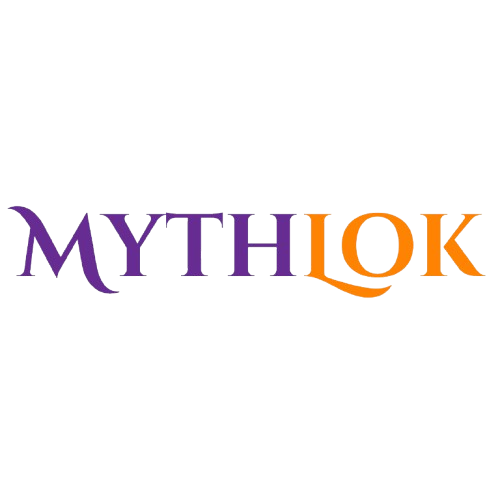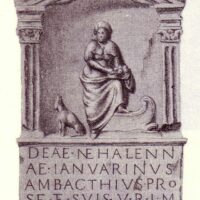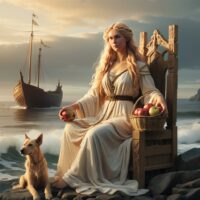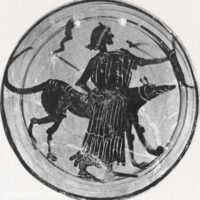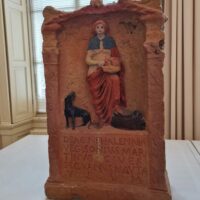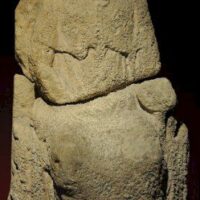Nehalennia : Guardian of the Seas
Listen
At a glance
| Description | |
|---|---|
| Origin | Germanic Mythology |
| Classification | Gods |
| Family Members | N/A |
| Region | Netherlands, Germany, Belgium |
| Associated With | Seafaring, Merchants, Boats, Ships, Seas |
Nehalennia
Introduction
Nehalennia is a mysterious and captivating figure from ancient mythology, venerated as a goddess of the sea, trade, and fertility. Her worship flourished in coastal regions bordering the North Sea—particularly in what is now the Netherlands, Belgium, and western Germany. While scholars debate whether her roots lie in Germanic, Celtic, or even Gallo-Roman traditions, what’s clear is that she held a powerful presence in the spiritual lives of ancient seafarers and merchants. Numerous votive altars dedicated to her, uncovered primarily in Zeeland, Netherlands, reveal a vibrant cult that sought her blessings for safe journeys and prosperous endeavors.
Physical Traits
Our understanding of Nehalennia comes mostly from stone carvings and altars that feature her image. These depict a serene, dignified woman seated on a throne, often adorned in distinctive garments that suggest both local and ceremonial significance. She’s frequently shown holding a basket of fruit—especially apples—or loaves of bread, symbols of nourishment and abundance. By her side, a loyal dog sits watchfully, possibly a protective companion or a symbol of guidance. Maritime elements, such as ship prows or sea motifs, often frame her figure, reinforcing her role as a guardian of travelers and the sea.
Family
There are no surviving myths or genealogies that detail Nehalennia’s familial connections, which sets her apart from many other ancient deities whose lineages are well-documented. Some researchers have proposed that she may have links to Vanic deities like Njord or Freyr, given her associations with the sea and prosperity. Others draw parallels to the Matres, a trio of mother goddesses found throughout Celtic and Germanic Europe. But overall, Nehalennia appears as a standalone divine presence—self-contained, powerful, and deeply tied to her region and its people.
Other names
Although “Nehalennia” is the most widely recognized form of her name, inscriptions from various sites reveal several variants, including Nehalenia, Nehalaennia, and Nehelennia. These variations likely stem from transliterations into Latin or regional dialects. In broader folk traditions across northern Europe, she may have been remembered under other names or epithets, such as Holda or Frau Gode—figures that similarly embody protective and maternal qualities.
Powers and Abilities
As a divine protector of those who crossed land and sea, Nehalennia held sway over safe travel, especially maritime voyages. Traders and sailors offered gifts at her altars before embarking on their journeys, hoping to gain her favor. Her connection to fertility and prosperity is reflected in the fruits and bread she’s often shown holding, marking her as a goddess of growth and success. There are also hints that she played a spiritual role during transitions—guiding and protecting those moving not only across geography but perhaps also through life’s significant thresholds.
Modern Day Influence
Nehalennia’s memory is far from forgotten. The rediscovery of her altars in Zeeland in the 17th and 19th centuries reignited interest in her legacy. Today, she has become a symbol of local pride and cultural heritage in the Netherlands. In 2005, a reconstructed temple dedicated to her was built in Colijnsplaat, drawing visitors, neopagan practitioners, and history enthusiasts alike. Her story has even reached pop culture, with references appearing in music by Dutch bands like Heidevolk and in the Japanese manga Sailor Moon. She’s increasingly viewed through a modern lens as a powerful feminine symbol—an ancient mother goddess reimagined for today’s world, especially within conversations about nature, sustainability, and female empowerment.
Related Images
Source
Dutch Archaeological Society – Nehalennia Worship
Ancient European Deities – Nehalennia’s Role
Zeeland Museum – Artifacts of Nehalennia
Derks, Ton. Gods, Temples, and Ritual Practices: The Transformation of Religious Ideas in Roman Gaul. Amsterdam University Press, 1998.
Roymans, Nico. Ethnic Identity and Imperial Power: The Batavians in the Early Roman Empire. Amsterdam University Press, 2004.
Versnel, H.S. Inconsistencies in Greek and Roman Religion. Brill Academic Publishers, 1993.
Frequently Asked Questions
What is lorem Ipsum?
I am text block. Click edit button to change this text. Lorem ipsum dolor sit amet, consectetur adipiscing elit. Ut elit tellus, luctus nec ullamcorper mattis, pulvinar dapibus leo.
What is lorem Ipsum?
I am text block. Click edit button to change this text. Lorem ipsum dolor sit amet, consectetur adipiscing elit. Ut elit tellus, luctus nec ullamcorper mattis, pulvinar dapibus leo.
What is lorem Ipsum?
I am text block. Click edit button to change this text. Lorem ipsum dolor sit amet, consectetur adipiscing elit. Ut elit tellus, luctus nec ullamcorper mattis, pulvinar dapibus leo.
What is lorem Ipsum?
I am text block. Click edit button to change this text. Lorem ipsum dolor sit amet, consectetur adipiscing elit. Ut elit tellus, luctus nec ullamcorper mattis, pulvinar dapibus leo.
What is lorem Ipsum?
I am text block. Click edit button to change this text. Lorem ipsum dolor sit amet, consectetur adipiscing elit. Ut elit tellus, luctus nec ullamcorper mattis, pulvinar dapibus leo.

